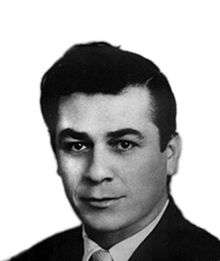Derviş Ali Kavazoğlu
| Derviş Ali Kavazoğlu | |
|---|---|
 | |
| Born |
April 4, 1924 Peristeronopigi, Famagusta, Cyprus |
| Died |
April 11, 1965 (aged 41) Goshi, Larnaca, Cyprus |
| Nationality | Cypriot |
Derviş Ali Kavazoğlu (April 4, 1924 – April 11, 1965) was a Turkish Cypriot member of the left wing AKEL party who was killed in 1965 by Turkish paramilitary group TMT.
Life
Derviş Ali Kavazoğlu was born in Peristerona, Famagusta on 4 April 1924. He started primary education in his home town, but after his father died when he was 5 years old, was relocated to live with family and continue school in the Turkish Cypriot municipality of Küçük Kaymaklı, Kaimakli. Owing to his poor background, he appealed for financial aid from the Evkaf to be able to carry on paying his tuition fees for secondary school with a bursary, but was denied. Consequently, he took up a trade and started working with a Greek Cypriot carpenter as an apprentice after completing primary school. Whilst progressing as an apprentice, he applied for membership to various local trade unions. At some point during his apprenticeship, Kavazoğlu began reading Marxist literature, the premises of which he began to advocate and which is rumoured to have influenced his eventual decision to join the socialist, Greek Cypriot, AKEL party.
Upon the completion of his carpentry apprenticeship, he opened his own carpenter's practise in Asmalti. During the initial periods of unrest at the start of the 1950s, when disenfranchised Turkish Cypriot's burned shops belonging to entrepreneur Necati Ozkan, Kavazoğlu’s establishment also caught fire among the blaze. In the aftermath of these events, he had to seek employment at another carpenter's practise. Having also had an interest in theatre, with the support of Turkish Cypriot unions, Kavazoğlu directed several dramatic productions. In 1954, he eventually raised enough capital to open a new shop in Belig Pasha Street, and practised there for a year.
In 1958, due largely to the murder of his friend and fellow leftist, İnkılâpçı editor Fazıl Önder, and furthermore fearing for his life as he was recognised himself as both a socialist and opponent to Taksim, Kavazoğlu moved to the predominantly Greek Cypriot southern quarter of Nicosia. From here, he produced counter-propaganda articles directly opposed to didactic which was being published by the de facto Turkish Cypriot leader and 'Taksim' advocate, Rauf Denktaş, in the lead up to the Independence of Cyprus in 1960. Kavazoğlu also established Turkish Cypriot groups against division after the independence was made official.
In 1964, he wrote in an article published by the United Nations; "recently, the thousands of Turco-Cypriots who are imprisoned in concentration camps by the hordes of Denktash, were ready to rise against the terrorists... a large segment of the Turkish Cypriots are ready to return to their villages".[1] The insinuation Kavazoğlu made was that the ever increasing Turkish Cypriot mass resettlements to refugee camps in the north of Cyprus were not due to the threat of Greek Cypriot violence, most notably by EOKA during Bloody Christmas (1963), but rather from the manipulation of pro-Taksim elements who sought to enforce a complete separation of the two significant Cypriot communities.
Greek Cypriot's awarded Kavazoğlu by appointing him as the head of "Cyprus Turkish Patriots Union", which was founded by AKEL. He also became a member of the Central Committee of Greek Cypriot AKEL, as well as the formal head of the party trade union.
Assassination
Kavazoğlu and Kostas Misiaoulis were proponents of peace between the Turkish Cypriot and Greek Cypriot communities on the island of Cyprus during the period of intercommunal violence. Whilst both were members of AKEL, Misiaolus was also a PEO trade union official. The two were shot to death on April 11, 1965 when they were ambushed on the Nicosia – Larnaca road, near the village of Goshi.[2] Both are held as symbols of Greek-Turkish solidarity and were commemorated in an event attended by Greek Cypriot President Dimitris Christofias in 2008.[3]
See also
- Christakis Vanezos: Derviş Ali Kavazoğlu, Λευκωσία - Christakis Vanezos: Derviş Ali Kavazoğlu, by Galeri Kultur Yeyinlari, Lefkosa
External links
- A short documentary in Turkish and Greek covering the assassination of Kavazoglou and Misiaoulis on YouTube
- Facebook fan page of Dervis Ali Kavazoglou
References
- ↑ United Nations S/5914
- ↑ http://www.famagusta-gazette.com/default.asp?sourceid=&smenu=69&twindow=&mad=&sdetail=2557&wpage=1&skeyword=&sidate=&ccat=&ccatm=&restate=&restatus=&reoption=&retype=&repmin=&repmax=&rebed=&rebath=&subname=&pform=&sc=2350&hn=famagusta-gazette&he=.com Famagusta Gazette
- ↑ http://www.cyprus-mail.com/news/main.php?id=38710&cat_id=1 Cyprus Mail